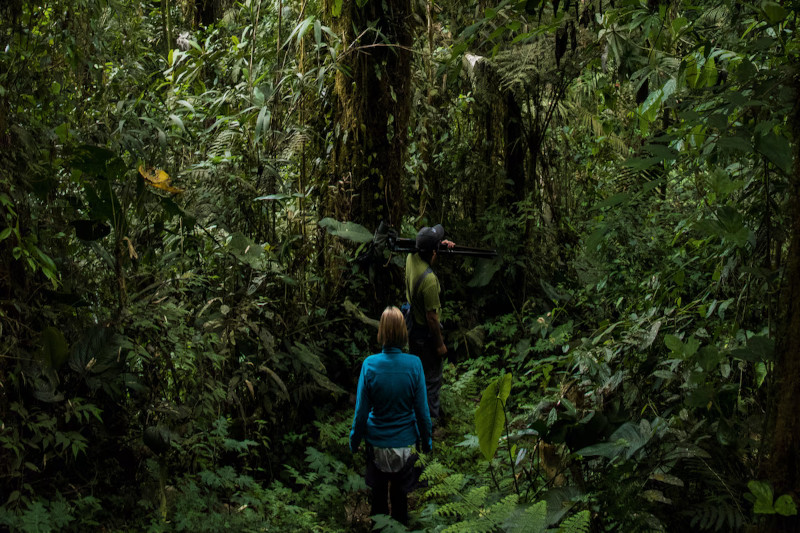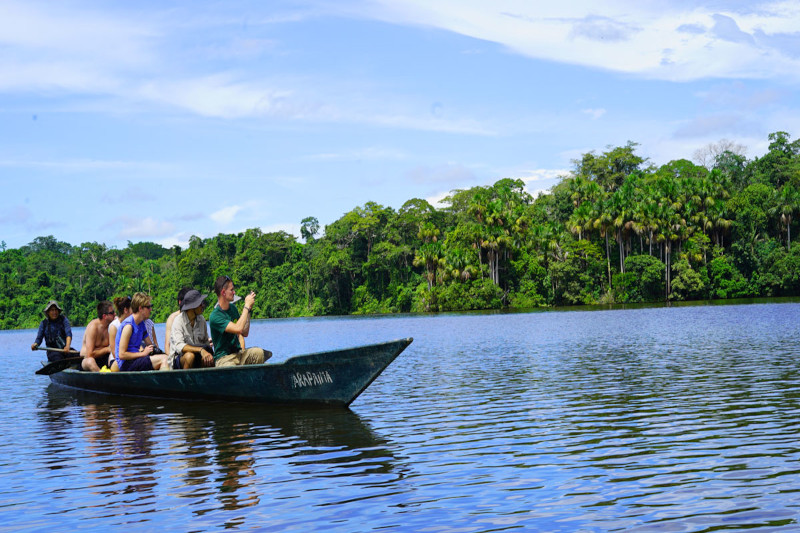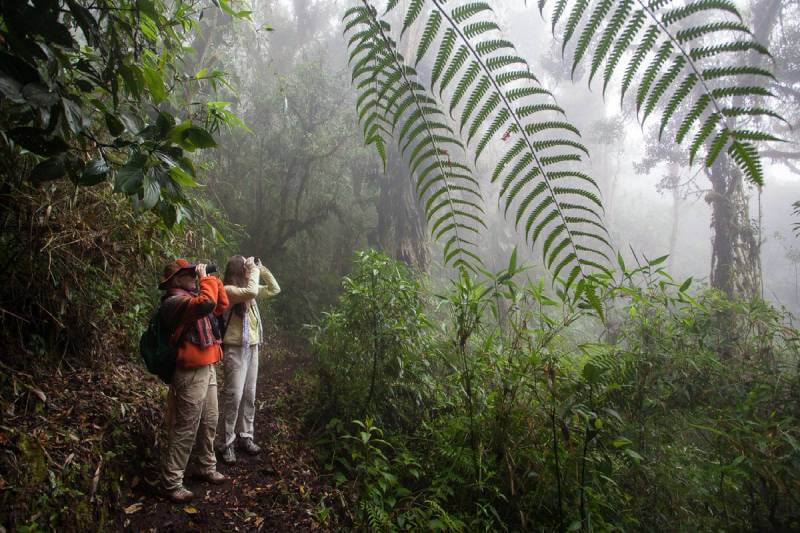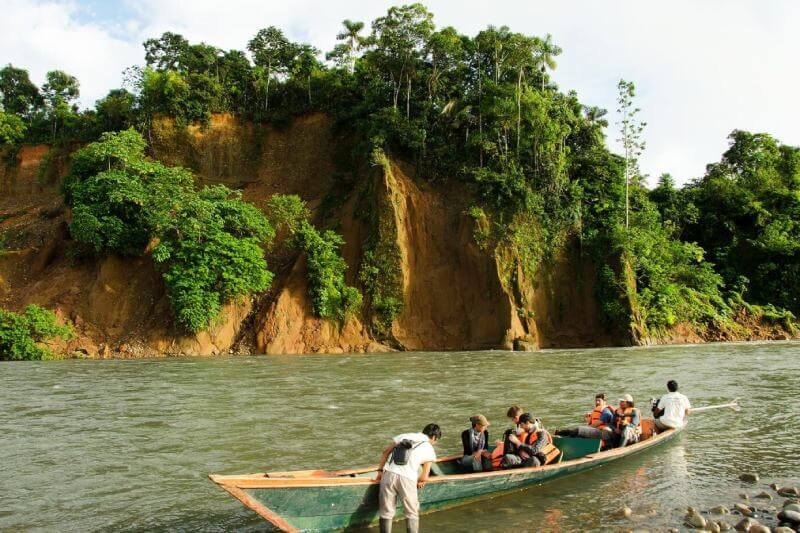The Peruvian Amazon is a biodiversity hotspot, home to thousands of plant and animal species. It spans over 60% of Peru’s territory and includes several national parks and reserves.
The region is split into two primary areas: the lowland jungle, called Selva Baja. The highland jungle, referred to as Selva Alta. Each area offers distinct ecosystems and experiences, making Peru a fascinating destination for nature lovers and adventurers alike. These ecosystems support a wide variety of life and are important for regulating the Earth’s climate and weather.
The Selva Baja is known for its thick, moist surroundings. People usually reach it by traveling along the rivers that flow through the area. This area is full of life. Travelers can see species that are hard to find anywhere else in the world.
In contrast, the Selva Alta offers a cooler, mountainous area. Here, the variety of plants and animals changes to fit the special conditions.
Both areas are important for scientific research and conservation. They provide valuable information about how different species interact with their environments. Exploring these areas requires a respectful and informed approach to ensure that they remain intact for future generations.

The Peru rainforest is a beautiful place. Visitors can see amazing animals, like bright macaws, playful monkeys, shy jaguars, and pink river dolphins. Additionally, the region is rich in cultural heritage, with indigenous communities preserving ancient traditions and lifestyles.
A trip to the Peru rainforest lets you connect with nature and learn about one of the most diverse ecosystems in the world. Seeing these animals in their natural environment gives important lessons about the fragile balance of life in the rainforest.
Furthermore, the cultural richness of the region is unparalleled. The local communities in these areas share their ancient traditions and ways of living. These practices have been handed down through many generations and focus on sustainability.
Learning about these communities helps you understand the rainforest better and supports the protection of their cultural heritage. When you visit the Peru rainforest, you help with conservation efforts and support the local economy. This way, both the environment and the people can succeed.

When planning a Peru rainforest tour, several factors must be considered to ensure a smooth and enjoyable experience. Here are some essential tips to keep in mind:
The best time to visit the Peru rainforest is during the dry season, which runs from May to October. During this period, rainfall is minimal, making it easier to navigate trails and access remote areas. The dry season is also ideal for wildlife spotting, as animals gather around water sources. This time of year often provides clearer skies, enhancing the experience of exploring the jungle’s vast expanses.
However, the rainy season from November to April has its own charm, with lush vegetation and fewer tourists. If you choose to visit during this time, be prepared for occasional downpours and plan your activities accordingly.
The rainforest is full of life during the wet season. You will see flowers blooming and animals active, giving you a new view of how the ecosystem works. Travelers during this period may also find it easier to engage more intimately with local communities and experience the rainforest without the crowds.
Responsible tourism is crucial for preserving the delicate ecosystem of the Peru rainforest. When choosing a tour operator, look for companies committed to sustainable practices, such as minimizing waste, supporting local communities, and promoting conservation efforts. Opt for tours that prioritize small group sizes to reduce environmental impact and ensure a more personalized experience. These operators often work closely with local guides who possess an intimate knowledge of the area, adding depth to your adventure.
Additionally, eco-friendly tour operators often contribute to research and conservation projects, helping to protect endangered species and restore habitats. By selecting a responsible tour provider, you are directly supporting efforts to maintain the integrity of the rainforest and its inhabitants. This conscious choice not only enhances your travel experience but also ensures that your visit leaves a positive legacy.
Packing for a Peru rainforest tour requires careful consideration of the region’s climate and terrain. Essential items include:
In addition to these essentials, consider bringing a hat and sunglasses to protect against the sun and a small backpack for daily excursions. A journal or notebook can be invaluable for recording your experiences and observations, allowing you to capture the essence of your adventure. Remember to pack any necessary medications and to leave space for souvenirs that support local artisans and communities.

A Peru rainforest tour offers a variety of activities and experiences, allowing you to immerse yourself in the region’s natural wonders and cultural richness. Here are some highlights to look forward to:
The Peru rainforest is home to an incredible array of wildlife, making it a paradise for animal enthusiasts. Guided walks and boat trips provide opportunities to spot iconic species such as sloths, toucans, and capybaras. For a truly unforgettable experience, embark on a night safari to observe nocturnal creatures in their natural habitat. These guided experiences are led by knowledgeable experts who can help identify the diverse species you encounter.
Beyond the more commonly seen animals, the rainforest is home to countless other creatures, from tiny insects to large mammals, each playing a vital role in the ecosystem. Birdwatchers will be particularly enthralled by the variety of avian species, many of which are endemic to the region.
Seeing a rare animal or watching how different species interact is a special moment for many visitors. It makes the adventure more exciting.
Engage with indigenous communities to learn about their traditional way of life and gain insight into their unique customs and beliefs. Many tours offer visits to local villages, where you can participate in cultural activities, sample traditional foods, and witness age-old craftsmanship. These interactions provide a deeper appreciation for the resilience and ingenuity of these communities.
Participating in workshops or demonstrations allows you to experience traditional practices firsthand, from weaving to pottery, and take home skills that have been honed over centuries. This cultural exchange is not only enlightening but also contributes to the preservation of these traditions. By supporting local initiatives, you help ensure that these communities can continue to thrive in harmony with their environment.
For thrill-seekers, the Peru rainforest offers a range of exciting activities, including canopy walks, zip-lining, and kayaking. Explore the lush canopy from above, paddle along winding rivers, or embark on a jungle trek to discover hidden waterfalls and secluded lagoons. These adventures provide a unique perspective on the rainforest’s vastness and complexity.
Participating in these activities often brings travelers into close contact with the raw beauty and power of nature. The thrill of gliding through the canopy or navigating a river’s twists and turns is exhilarating and unforgettable. These adventures encourage a deeper connection with the natural world, fostering a sense of stewardship and appreciation for its wonders.

While the Peru rainforest is a remarkable destination, it’s essential to prioritize safety and well-being throughout your journey. Here are some tips to ensure a safe and healthy experience:
Before traveling, consult your healthcare provider about necessary vaccinations and medications, such as malaria prophylaxis. Carry a basic first aid kit and any personal medications you may need. Staying hydrated and applying insect repellent regularly will help protect you from common health risks. It’s also wise to familiarize yourself with the symptoms of common tropical illnesses so you can recognize and address them promptly.
In addition to vaccinations, ensure you have adequate travel insurance that covers medical emergencies and evacuation if necessary. Drinking only bottled or purified water and being cautious about food hygiene will further safeguard your health during your visit. These precautions will allow you to focus on enjoying your adventure without unnecessary worry.
Always follow the guidance of your tour guide, who is familiar with the local environment and potential hazards. Stick to designated paths and avoid touching unfamiliar plants or animals. It’s also important to respect local customs and traditions and seek permission before taking photographs of people or cultural sites. This respect extends to the environment, where even the smallest actions can have significant impacts.
Being aware of your surroundings and listening to local advice will enhance your safety and ensure a more rewarding experience. By adhering to these guidelines, you contribute to the preservation of the rainforest and its communities, allowing future travelers to enjoy the same wonders. Responsible behavior is key to maintaining the delicate balance of this extraordinary environment.

A Peru rainforest tour is a journey of discovery, offering unparalleled opportunities to connect with nature and explore one of the world’s most biodiverse regions. By planning thoughtfully and embracing responsible travel practices, you can ensure a rewarding and memorable adventure that leaves a positive impact on the environment and local communities. Each step taken with care and consideration contributes to the ongoing preservation of this vital ecosystem.
Whether you’re a seasoned traveler or embarking on your first expedition, the Peru rainforest awaits with its vibrant landscapes, captivating wildlife, and rich cultural heritage. Let this guide serve as your roadmap to an unforgettable experience in the heart of the Amazon. Immerse yourself in the beauty and complexity of this unique region, and return home with stories and memories that will last a lifetime.
